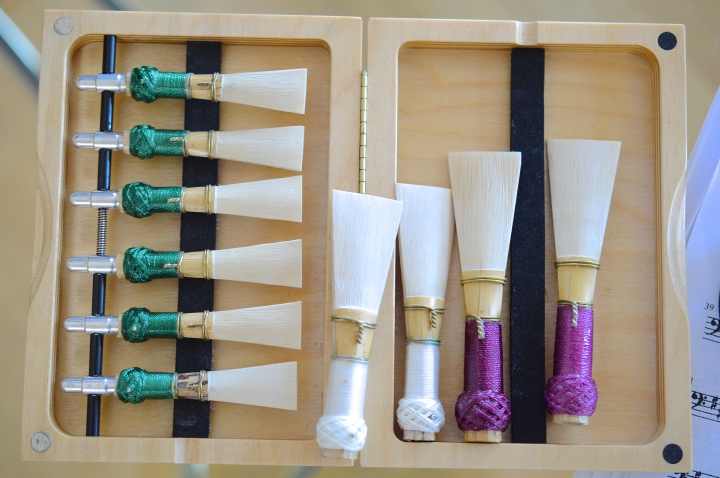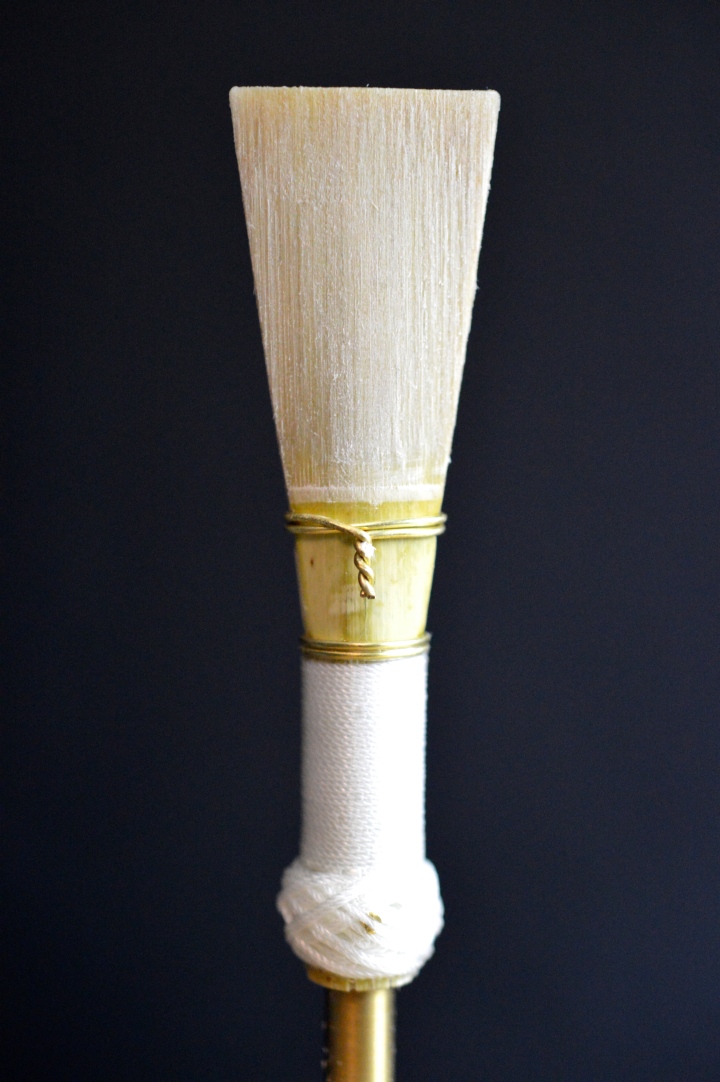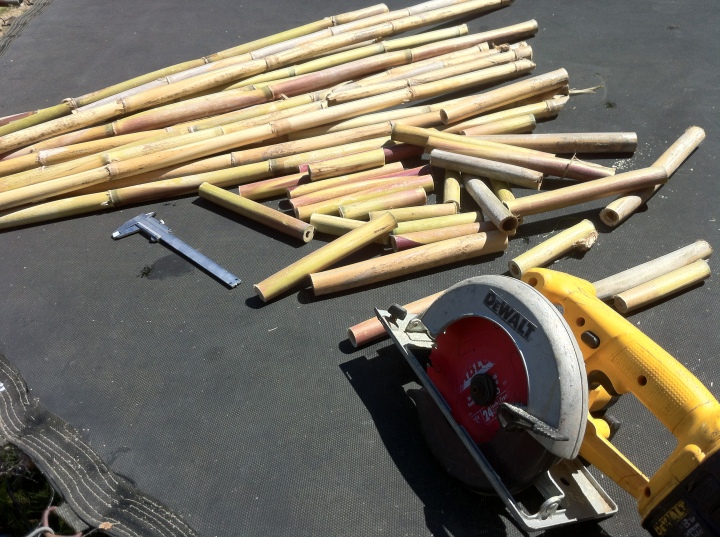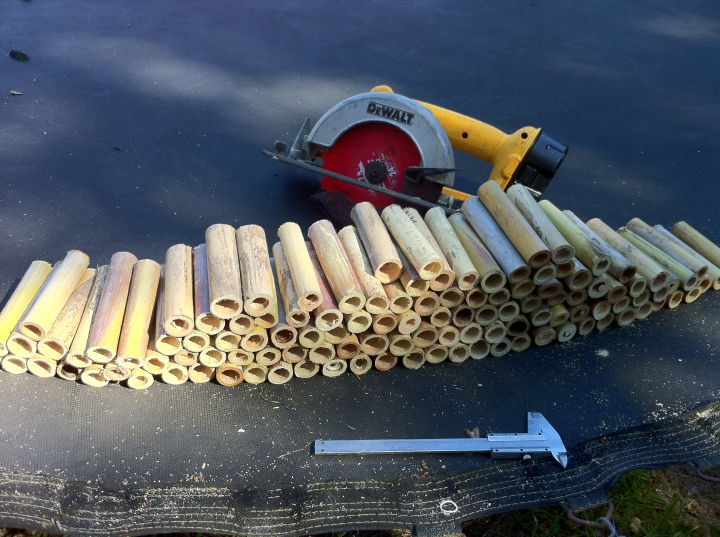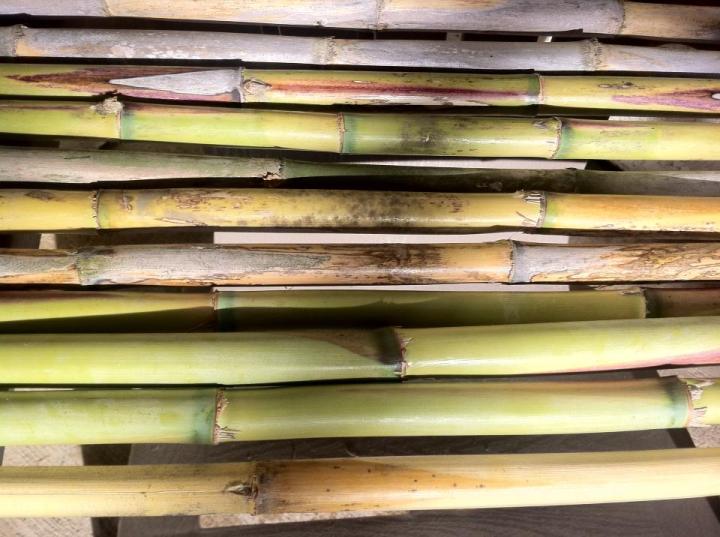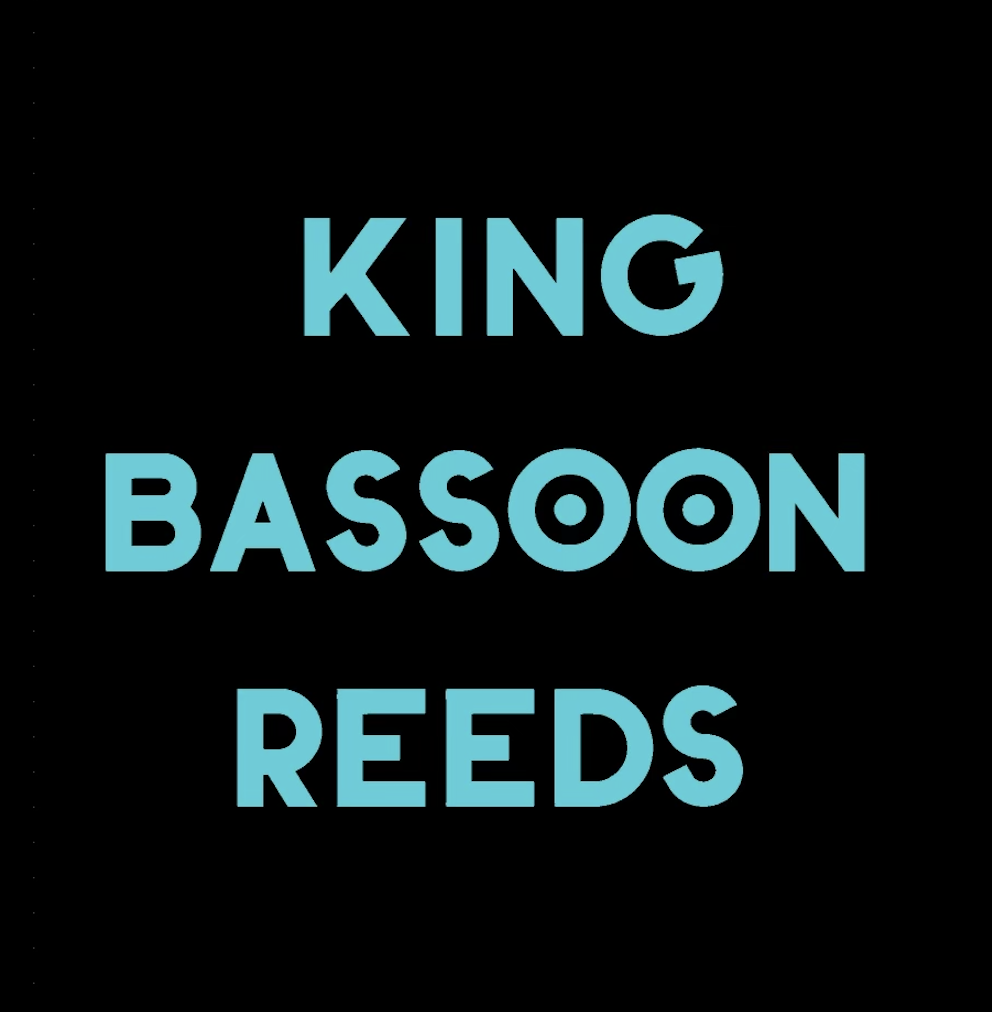reed
King Bassoon Reeds
I have just started working with a new batch of cane and it is very high quality. This is cane that was cut 2 years ago and is on the harder side. It seems more middle of the road and has been great with the Fox 2 shape for bassoon and Reiger K1 on contrabassoon. If you are interested in some reeds head over to King Bassoon Reeds or email me if you are interested in cane.
Green Reed!?
I tried an experiment last week involving a Green Reed for Contraforte. I just harvested some cane in early January and decided to try to immediately make a reed out of it instead of letting it dry. And this is what turned out! I regular reed that sounded and acted like any other reed but it was fresh green cane and didnt need to be soaked in water before I played on it. The texture was similar to a very hard piece of cane so I had to make this thinner than I would normally. After a few days it started to dry out and warp and is now is playing very sharp. Next I’m going to try this on regular bassoon.
I would suggest trying it to all of the cane harvesters out there!
Contrabassoon Reeds Contraforte Reeds
Kingbassoonreeds.com is now more affordable for contra players! The Price of Contrabassoon reeds and Contraforte reeds has dropped due to a great turnout of harvested cane from last spring. So Now there is no penalty for being a contra player!
Contraforte: A Year in Review
December 2013 was a very important month for me because of the purchase of a Contraforte. This horn was owned by Lewis Lipnick of the National Symphony in Washington D.C. (who is an amazing person and an amazing player) When I bought it, I drove my little Prius from San Francisco to Washington DC to pick it up and drive it back. Now that I have had it for a year I think I am in a better place to talk about my experience with this instrument. My reason for writing this is the same reason for this entire website, basically consumer reports. So many cool new gadgets have been coming out in the woodwind world recently without much user reviews. When I spend money on new equipment I do research to see how it is received by players before I decide to purchase it.
Origin Story (skip this)
In my undergraduate studies at the San Francisco Conservatory I played a little contrabassoon here and there as needed but it never stuck with me. Then after graduating I went and played contra with the San Luis Obispo Symphony for a year. The symphony had an Amati contrabassoon that I was allowed to borrow and keep in my possession full time and this is when I started getting into contra. By having a contra at my house that I didn’t have to share, I put in some practice hours and messed around with reeds. I ended up really liking contrabassoon and decided to go back to the conservatory to study contra with Steve Braunstein of the San Francisco Symphony (another amazing person and amazing player) I was using the SFCM Fox contra which is in need of service and a better bocal so I was frustrated. I was looking around the used contrabassoon market all summer and fall looking for anything worthwhile, but the contra market is slow/limited, very difficult to play test without committing to buy. My thought at the time was that many people have middle range contras with the intention of upgrading sometime in the future, but I would rather just spend some money on a nice contra now and have it for the rest of my life. So I contacted a few big players all around America to see if they new of any contras for sale. Lew got back to me and said that he was selling his current Wolf Contraforte (#35 circa 2009) and replacing it with a new CF which had a few updated acoustics.
January-March
For the last year or so I had been playing contrabassoon for at least an hour a day so I was used to the fingerings, air pressure, and reeds. I am the kind of person who takes a while to adjust to new instruments, even to the point that play testing instruments for a few minutes is a waste on me. So when I first had the Contraforte I really didn’t like it. I was able to play low notes slowly and sort of go through the fingering chart and play the full range. There were huge problems immediately; I was very sharp, I only had one reed, and I could only play forte and louder. I new that the contraforte needed reeds that were larger than the contrabassoon but I didn’t realize that I needed special machines. So I was going to be completely reliant on Hank Skolnick to make all of my reeds for me. I decided within the first month of having the CF that I needed to have my own gouger and profiler if I was going to make this instrument play correctly for me. So with a little student loan money and the help of Steve B and Chris van Os I got a pair of machines. I tried all sorts of dimensions and shapes but 160mm cane with the Reiger contraforte shaper was always the best result, and still what I use. I should mention that the CF comes with an adaptor to fit regular contrabassoon reeds but middle F# cracks nonstop and so does tenor Db. I read somewhere that they also can make a bocal which is slightly longer and fit a regular contrabassoon reed, which might be better than the adaptor (which creates a dramatic flare in the bore right at the beginning) The CF does not have a tuning slide and is built closer to 442 than 440. Compared to a CB this is strange, but similar to bassoon you just learn to make a reed that plays in tune since there are no moving parts for tuning. I was at this time very primitive in the reed stuff and experimenting with the gouge, profile, thick/thin rails, think/thin heart, think/thin tip. Each reed in the reed case was individual and I wasn’t able to duplicate the same reed, the tones possible with those reeds ranged from distant muted tuba to amplified chainsaw.
April-June
I needed to have a recital to graduate and I had been spending way too much time on contra and not enough on bassoon. So I put a contraforte show together with the Mozart oboe concerto, a Mignone Waltz and Sonatina d’Amore which is a contrabassoon duet. The contraforte played great despite a few operator errors, and was received very well. I was experimenting with narrower shapes at this point using a Rieger K1 with 160mm cane. This created a simpler reedier sound a lot like a contrabassoon. The SFCM orchestra was playing Don Juan, the big oboe solo in the middle is accompanied by a drone low G in the contra. At the time, this narrower shape was the only way that I was able to play quiet enough. I always had a few of these narrower reeds in my reed case, the issue was that the internal volume of the reed was not enough for the entire range of the instrument. It seemed that I could make a reed with a resonant low register but too thin in the higher register; or a high note reed that was sharp in the low register.
July-September
Over the summer I bought a few more gadgets, with the help of Trent at Midwest Musical Imports. I bought the contraforte stand and gigbag from Wolf. The stand is huge asset, since the horn doesn’t come apart it isn’t possible to clean it out very much. Leaving it out on the stand is essential so that it is able to dry out. For reeds I was completely on the Rieger C2 which is the contraforte shape, this is the shape I have used full time since. The San Francisco Opera was auditioning utility bassoon and contrabassoon and I took the audition along with everyone else from the Bay Area. It seems like the CF is something that people invest in after they hold a contra position, so not many contrafortes have been in auditions. I played alright but nothing special and I didn’t pass into the finals. This was a good hurdle for me to audition on a new horn and it made me more comfortable playing in public. The end of the summer was mostly playing contra duets with people, not so much to show the instrument but to work on blending with other contras and finish sorting out pitch issues.
October-December
Recently I have been continuing my quest for stealing repertoire from other instruments. The range of the contraforte allows me to borrow cello music and the quick response lets me play high woodwind pieces. My last recital had the Brahms Cello Sonata no.1, the Hindemith english horn Sonata, and Syrinx. The contraforte performs great with piano, since I didn’t change the piano parts some of the voicing clashes with the range of the contra. However the tone of the CF is still clear over the piano. I have settled on a reed design which uses the wider reed shaper, Rieger C2, and I leave the blade quite thick. I clean up the collar area and even out the tip but the profiler from Chris van Os is adjusted in such a way that I need to do very little. Having a heavier tip creates a darker sound with easy high notes and the reed doesn’t warp as much in humidity/temperature changes.

Things to Remember about Contraforte
*It’s heavier than a contrabassoon
*Contraforte cane cannot be processed on contrabassoon machines
*Most parts and pieces can only be replaced by Wolf
*Larger dynamic and notation range
*Stable intonation and timbre
Cane Harvest part II
This is the second post from my recent cane harvest. I harvested a bunch of cane from the Ventura river and dried it out. Now it’s time to get to the rest of the cane processes.
First I cut the “knuckles” out of the cane. These are the connecting sections of the cane that hold the shoots together. Since these knots are unusable it’s import to take them out without removing any extra cane, so I cut as close to the knots as I can.
At this point all of the cane is free of the joints. This will help all of the sections of cane to dry more evenly. Some of the shoots were in the middle of a stalk of cane, and weren’t uniformly exposed to air.
Now with a caliper, I measure out every shoot of cane and mark the cut. I cut my cane to 120 millimeters because this fits all of my equipment. It’s important to keep in mind that cane continues to shrink as it dries out. So when cutting in the last few stages, its better to leave a millimeter or two extra.
After all of the cane is cut to size, I store it vertically in a plastic bin. I leave the lid off and rotate it once a week since it is still drying out.
Home grown and harvested tube cane isn’t as pretty as store bought tube cane, but it cane be. Cane companies add a few extra steps like steam cleaning (which also sanitizes) they also sort out pieces with color variations. Home harvested cane isn’t quite as reliable as store bought cane either, not every piece cane be expected to become a good reed.
Cane Harvesting
I have the great advantage of living by a field of naturally occurring Arundo Donax. My mother lives in Ventura, California and the Ventura river, from the Ojai river, is infested with an unending source of cane. The easiest place for me to collect this cane is where the river meets the Ocean. The is however a problem with this cane, since it grows basically on a beach, it is very weathered and dry. From what I have experienced so far, much of this damaged cane makes very soft reeds. The sun, sand, salt, wind, humidity, and temperature take much of nutrients from the cane and leave it very porous and soft. The best cane is in the middle of the fields, so it takes a bit of work to get to, but this cane is the most protected.
All of the pieces I have cut are in different phases of the drying process. I have read many articles about the drying process and what some of the big cane producers do. First I have read from two separate sources to harvest cane the day after a full moon. “the pitch is up” and something about the gravitational difference of having the moon high in the sky during the day pulls resources from the roots into the fibers. From there on the process is very different company to company. Most french companies keep the cane outside to dry in a “teepee” formation for a whole year. Where as the Rico company keeps the freshly harvested cane outside in the sun for 10 days and then moves it all into huge indoor storage facilities and large ventilator fans.
For my part I am going to harvest enough cane to allow me to try a number of different methods. Some I will leave outside, others will stay mostly inside, and others I might cut to shorter segments to see if it will dry faster. Most of the pieces I cut are 5-6 segments long and so ill have different sections of the same cane to work with.
Ill be sure to post pictures of the reeds made from this harvested cane!
Legère bassoon reed
Legère has been well known for having synthetic single reeds which have been mostly used for marching bands or for doublers who don’t want to keep up with reeds for multiple instruments. This fall they have released a synthetic bassoon reed.
I have played on plastic bassoon reeds before, Charles music makes one and so does wwbw.com. These reeds are really intended for beginners to get a feel for the basic technique of bassoon and learn the first few notes. They sound very bright but passable in the low register, not much in the tenor register. That is the quality of sound that i was expecting from the Legère reeds as well. My teacher Steve Paulson played on them with the San Francisco Symphony and he sounded amazing. So i decided to put my name on the list and buy one.
The shipping took some time but the company is in Canada so its understandable. I first played a few long tones and it was a little resistant. I make reeds that are easy blowing and respond with very little effort, they can tend to be bright sounding. So in comparison this reed was a bit hard for me.
Its been a few weeks and I have been using this reed exclusively. I have gotten completely used to it and it is capable of producing a very full rich sound with a little bit of push. The tenor register especially needs a little boost to get a good vibrato. I clipped the corners and it allows me to tongue easier without the sharp edges. Double tonguing fast passages takes some getting used to as every note has a bit more resistance to get started. These reeds come in three densities: soft, medium, hard. I use soft and so does everyone i know who uses one. These reeds have more playing resistance than cane reeds.
I would recommend that everyone gets one of these to keep in the back of their reed cases for bad weather days or traveling. I have been in between apartments in San Francisco and all of my reed making equipment is packed up so if I had been using cane reeds i would have been out of usable reeds by now, not to mention the drastic weather changes here in the city.

Rieger Cane
ive recently been buying Rieger cane. I buy it gouged and profiled, and i think that Rieger has set their profilers limits too narrow. That is, the distance between one collar and the other collar of unfolded cane is closer than what im used to. Now there is an immediate advantage to this, after forming the reed less material needs to be clipped from the tip in order to open the reed. That extra can length is instead now part of the tube. So the overall reed is longer despite where the tip is cut. For those players who are always sharp, this may be an answer. It can be as dramatic as choosing a longer bocal but instead having the ability to shorten it by reaming.
Bach c minor Gigue
Bach c minor Gigue

